冲压 文献综述
- 格式:doc
- 大小:36.50 KB
- 文档页数:7
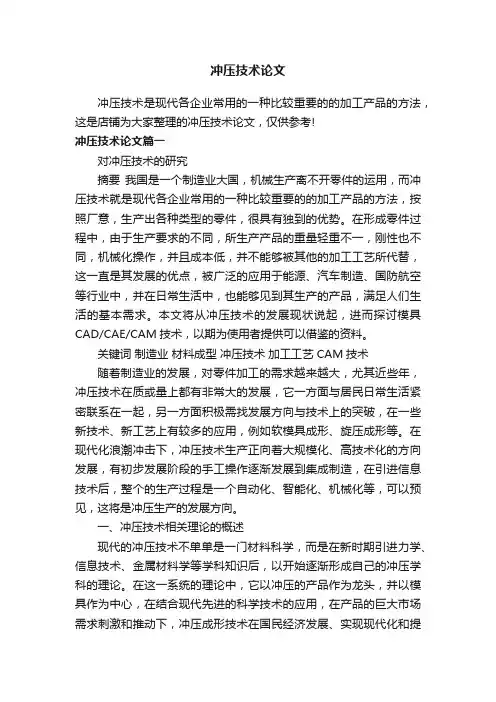
冲压技术论文冲压技术是现代各企业常用的一种比较重要的的加工产品的方法,这是店铺为大家整理的冲压技术论文,仅供参考!冲压技术论文篇一对冲压技术的研究摘要我国是一个制造业大国,机械生产离不开零件的运用,而冲压技术就是现代各企业常用的一种比较重要的的加工产品的方法,按照厂意,生产出各种类型的零件,很具有独到的优势。
在形成零件过程中,由于生产要求的不同,所生产产品的重量轻重不一,刚性也不同,机械化操作,并且成本低,并不能够被其他的加工工艺所代替,这一直是其发展的优点,被广泛的应用于能源、汽车制造、国防航空等行业中,并在日常生活中,也能够见到其生产的产品,满足人们生活的基本需求。
本文将从冲压技术的发展现状说起,进而探讨模具CAD/CAE/CAM技术,以期为使用者提供可以借鉴的资料。
关键词制造业材料成型冲压技术加工工艺 CAM技术随着制造业的发展,对零件加工的需求越来越大,尤其近些年,冲压技术在质或量上都有非常大的发展,它一方面与居民日常生活紧密联系在一起,另一方面积极需找发展方向与技术上的突破,在一些新技术、新工艺上有较多的应用,例如软模具成形、旋压成形等。
在现代化浪潮冲击下,冲压技术生产正向着大规模化、高技术化的方向发展,有初步发展阶段的手工操作逐渐发展到集成制造,在引进信息技术后,整个的生产过程是一个自动化、智能化、机械化等,可以预见,这将是冲压生产的发展方向。
一、冲压技术相关理论的概述现代的冲压技术不单单是一门材料科学,而是在新时期引进力学、信息技术、金属材料学等学科知识后,以开始逐渐形成自己的冲压学科的理论。
在这一系统的理论中,它以冲压的产品作为龙头,并以模具作为中心,在结合现代先进的科学技术的应用,在产品的巨大市场需求刺激和推动下,冲压成形技术在国民经济发展、实现现代化和提高人民生活水平方面发挥着越来越重要的作用。
冲压自动化生产的实现使冲压制造的概念有了本质的飞跃。
结合现代技术信息系统和现代化管理信息系统的成果,由这三方面组合又形成现代冲压新的生产模式―计算机集成制造系统CIMS。
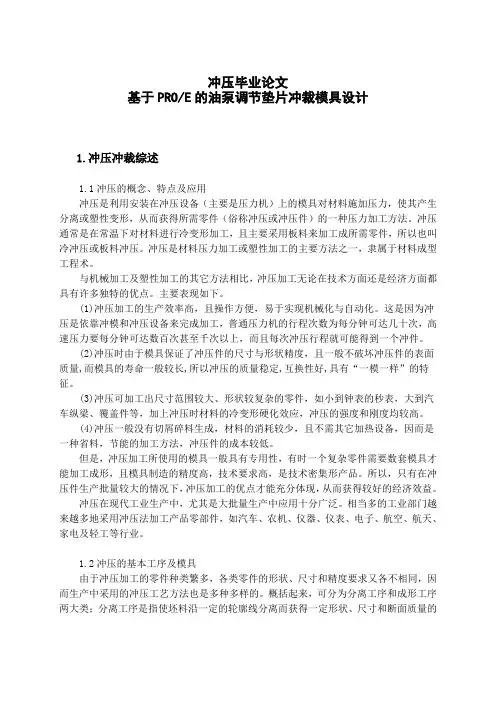
冲压毕业论文基于PRO/E的油泵调节垫片冲裁模具设计1.冲压冲裁综述1.1冲压的概念、特点及应用冲压是利用安装在冲压设备(主要是压力机)上的模具对材料施加压力,使其产生分离或塑性变形,从而获得所需零件(俗称冲压或冲压件)的一种压力加工方法。
冲压通常是在常温下对材料进行冷变形加工,且主要采用板料来加工成所需零件,所以也叫冷冲压或板料冲压。
冲压是材料压力加工或塑性加工的主要方法之一,隶属于材料成型工程术。
与机械加工及塑性加工的其它方法相比,冲压加工无论在技术方面还是经济方面都具有许多独特的优点。
主要表现如下。
(1)冲压加工的生产效率高,且操作方便,易于实现机械化与自动化。
这是因为冲压是依靠冲模和冲压设备来完成加工,普通压力机的行程次数为每分钟可达几十次,高速压力要每分钟可达数百次甚至千次以上,而且每次冲压行程就可能得到一个冲件。
(2)冲压时由于模具保证了冲压件的尺寸与形状精度,且一般不破坏冲压件的表面质量,而模具的寿命一般较长,所以冲压的质量稳定,互换性好,具有“一模一样”的特征。
(3)冲压可加工出尺寸范围较大、形状较复杂的零件,如小到钟表的秒表,大到汽车纵梁、覆盖件等,加上冲压时材料的冷变形硬化效应,冲压的强度和刚度均较高。
(4)冲压一般没有切屑碎料生成,材料的消耗较少,且不需其它加热设备,因而是一种省料,节能的加工方法,冲压件的成本较低。
但是,冲压加工所使用的模具一般具有专用性,有时一个复杂零件需要数套模具才能加工成形,且模具制造的精度高,技术要求高,是技术密集形产品。
所以,只有在冲压件生产批量较大的情况下,冲压加工的优点才能充分体现,从而获得较好的经济效益。
冲压在现代工业生产中,尤其是大批量生产中应用十分广泛。
相当多的工业部门越来越多地采用冲压法加工产品零部件,如汽车、农机、仪器、仪表、电子、航空、航天、家电及轻工等行业。
1.2冲压的基本工序及模具由于冲压加工的零件种类繁多,各类零件的形状、尺寸和精度要求又各不相同,因而生产中采用的冲压工艺方法也是多种多样的。

冲压专业文献综述文献综述10909010229颜熙摘要:在科技技术日益发展的今天,冲压工艺得到不断的发展,在工业生产中的作用越来越重要。
冲压技术在新技术、新工艺、新设备、新材料的涌现下,不断革新和发展。
本文从复合模的特点,使用原则,正装倒装结构,探讨了复合模具的冲压工艺。
关键词:冲压工艺、复合模、工艺设计Abstract: in the increasingly development of science and technology today, the stamping process has been developed constantly, in the industrial production more and more important roles in stamping technology in the emergence of new technology and new technology new equipment, new material, the constant innovation and development in this paper, from the characteristics of composite modulus, use principle, formal inversion structure, discusses the composite die stamping process Keywords: stamping process, compound die, process design1.冲压的概念及其优点1.1冲压的概念冲压是利用安装在冲压设备(主要是压力机)上的模具对材料施加压力,使其产生分离或塑性变形,从而获得所需零件(俗称冲压或冲压件)的一种压力加工方法。
冲压通常是在常温下对材料进行冷变形加工,且主要采用板料来加工成所需零件,所以也叫冷冲压或板料冲压。

文献综述1 引言冲压模具是冲压生产必不可少的工艺装备,是技术密集型产品。
冲压件的质量、生产效率以及生产成本等,与模具设计和制造有直接关系。
模具设计与制造技术水平的高低,是衡量一个国家产品制造水平高低的重要标志之一,在很大程度上决定着产品的质量、效益和新产品的开发能力。
2005 年—2008 年,我国冲压模具产品均出口较大幅度的增长。
2009 年在全球高压锅炉管市场总需求量下降的情况下,国际采购商通过国内某网站采购冲压模具的数量仍逆势上扬。
我国冲压模具的国际竞争力正在不断提升。
根据我国海关统计资料显示,2005 年—2008 年,我国冲压模具产品均出口较大幅度的增长。
2008 年,即使遭受全球金融危机,我们冲压模具出口金额达4.11 亿美元,比2007 年的 3.26 亿美元增长了26。
另外,2009 年在全球高压锅炉管市场总需求量下降的情况下,国际采购商通过国内某网站采购冲压模具的数量仍逆势上扬。
从全年采购情况来看,总体趋于上涨的趋势。
其中,2009 年下半年回暖明显,国际采购商借此网站采购频次约616 频次,比上半年的288 频次增长了114%。
虽然近年来我国模具行业发展迅速,但是离国内的需要和国际水平还有很大的差距。
差距较大主要表现在:(1)标准化程度低。
(2)模具制造精度低、周期长。
解决这些问题主要体现在模具设计上,故改善模具设计的水平成为拉近差距的关键性问题。
若要很好的设计出一副冲压模具,就必须去了解冲压模具的历史、现状以及发展趋势。
2 主体 2.1 冲压模具的发展历史我国考古发现,早在2000 多年前,我国已有冲压模具被用于制造铜器,证明了中国古代冲压成型和冲压模具方面的成就就在世界领先。
1953 年,长春第一汽车制造厂在中国首次建立了冲模车间,该厂于1958 年开始制造汽车覆盖件模具。
我国于20 世纪60年代开始生产精冲模具。
在走过了温长的发展道路之后,目前我国已形成了300 多亿元(未包括港、澳、台的统计数字,下同)各类冲压模具的生产能力。
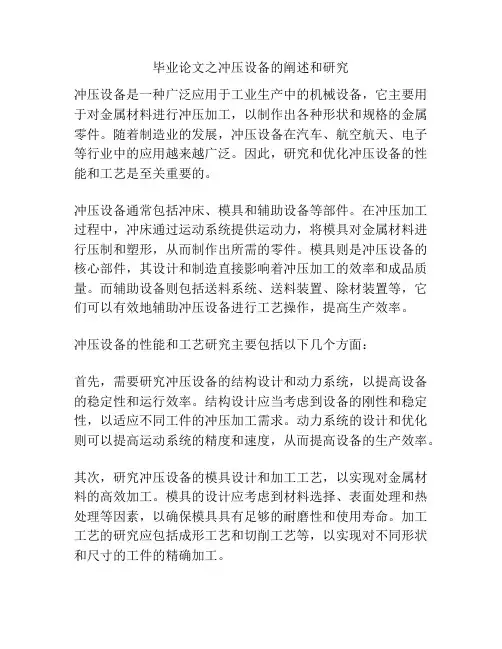
毕业论文之冲压设备的阐述和研究冲压设备是一种广泛应用于工业生产中的机械设备,它主要用于对金属材料进行冲压加工,以制作出各种形状和规格的金属零件。
随着制造业的发展,冲压设备在汽车、航空航天、电子等行业中的应用越来越广泛。
因此,研究和优化冲压设备的性能和工艺是至关重要的。
冲压设备通常包括冲床、模具和辅助设备等部件。
在冲压加工过程中,冲床通过运动系统提供运动力,将模具对金属材料进行压制和塑形,从而制作出所需的零件。
模具则是冲压设备的核心部件,其设计和制造直接影响着冲压加工的效率和成品质量。
而辅助设备则包括送料系统、送料装置、除材装置等,它们可以有效地辅助冲压设备进行工艺操作,提高生产效率。
冲压设备的性能和工艺研究主要包括以下几个方面:首先,需要研究冲压设备的结构设计和动力系统,以提高设备的稳定性和运行效率。
结构设计应当考虑到设备的刚性和稳定性,以适应不同工件的冲压加工需求。
动力系统的设计和优化则可以提高运动系统的精度和速度,从而提高设备的生产效率。
其次,研究冲压设备的模具设计和加工工艺,以实现对金属材料的高效加工。
模具的设计应考虑到材料选择、表面处理和热处理等因素,以确保模具具有足够的耐磨性和使用寿命。
加工工艺的研究应包括成形工艺和切削工艺等,以实现对不同形状和尺寸的工件的精确加工。
最后,可以对冲压设备的自动化控制和智能化技术进行研究,以提高设备的生产效率和生产质量。
自动化控制技术可以实现设备的全自动化生产,减少人为操作的干扰,提高生产效率和安全性。
智能化技术则可以实现对设备生产数据的实时监测和分析,为生产过程的优化提供数据支持。
总之,冲压设备的性能和工艺研究是制造业发展的重要方向之一,它将为提高冲压加工的效率和质量,促进工业生产的现代化和智能化发挥重要作用。
因此,对冲压设备的结构设计、模具设计和加工工艺、自动化控制和智能化技术的研究和优化具有重要意义。
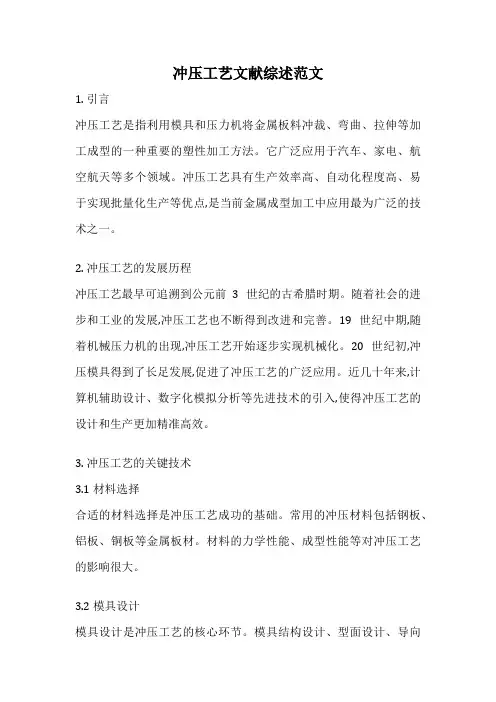
冲压工艺文献综述范文1. 引言冲压工艺是指利用模具和压力机将金属板料冲裁、弯曲、拉伸等加工成型的一种重要的塑性加工方法。
它广泛应用于汽车、家电、航空航天等多个领域。
冲压工艺具有生产效率高、自动化程度高、易于实现批量化生产等优点,是当前金属成型加工中应用最为广泛的技术之一。
2. 冲压工艺的发展历程冲压工艺最早可追溯到公元前3世纪的古希腊时期。
随着社会的进步和工业的发展,冲压工艺也不断得到改进和完善。
19世纪中期,随着机械压力机的出现,冲压工艺开始逐步实现机械化。
20世纪初,冲压模具得到了长足发展,促进了冲压工艺的广泛应用。
近几十年来,计算机辅助设计、数字化模拟分析等先进技术的引入,使得冲压工艺的设计和生产更加精准高效。
3. 冲压工艺的关键技术3.1 材料选择合适的材料选择是冲压工艺成功的基础。
常用的冲压材料包括钢板、铝板、铜板等金属板材。
材料的力学性能、成型性能等对冲压工艺的影响很大。
3.2 模具设计模具设计是冲压工艺的核心环节。
模具结构设计、型面设计、导向系统设计等都会影响冲压件的质量。
计算机辅助设计和数字化仿真分析技术的应用,使得模具设计更加科学合理。
3.3 成型工艺成型工艺包括冲裁、弯曲、拉伸、模塑等多种工艺,不同的工艺用于制造不同的冲压件。
工艺参数的优化控制对于提高产品质量、降低生产成本至关重要。
3.4 质量控制冲压工艺涉及材料、模具、设备、工艺等多个环节,需要全面的质量控制措施来确保产品质量。
常用的质量控制方法包括统计过程控制、故障模式与影响分析等。
4. 冲压工艺的发展趋势4.1 绿色环保化未来的冲压工艺需要朝着绿色环保的方向发展,如采用新型环保材料、节能减排工艺等。
4.2 智能化和自动化通过引入人工智能、机器视觉等新兴技术,实现冲压工艺的智能化和自动化,提高生产效率和产品质量。
4.3 轻量化设计为满足节能减排的需求,未来冲压工艺需要向轻量化设计发展,如采用新型高强度轻质材料等。
5. 结语冲压工艺作为一种重要的金属塑性加工方法,在工业生产中发挥着重要作用。

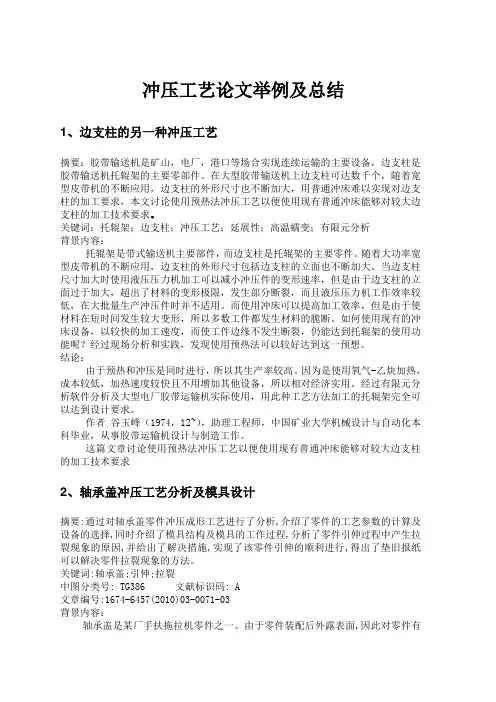
冲压工艺论文举例及总结1、边支柱的另一种冲压工艺摘要:胶带输送机是矿山,电厂,港口等场合实现连续运输的主要设备,边支柱是胶带输送机托辊架的主要零部件。
在大型胶带输送机上边支柱可达数千个,随着宽型皮带机的不断应用,边支柱的外形尺寸也不断加大,用普通冲床难以实现对边支柱的加工要求,本文讨论使用预热法冲压工艺以便使用现有普通冲床能够对较大边支柱的加工技术要求。
关键词:托辊架;边支柱;冲压工艺;延展性;高温蠕变;有限元分析背景内容:托辊架是带式输送机主要部件,而边支柱是托辊架的主要零件。
随着大功率宽型皮带机的不断应用,边支柱的外形尺寸包括边支柱的立面也不断加大。
当边支柱尺寸加大时使用液压压力机加工可以减小冲压件的变形速率,但是由于边支柱的立面过于加大,超出了材料的变形极限,发生部分断裂,而且液压压力机工作效率较低,在大批量生产冲压件时并不适用。
而使用冲床可以提高加工效率,但是由于使材料在短时间发生较大变形,所以多数工件都发生材料的脆断。
如何使用现有的冲床设备,以较快的加工速度,而使工件边缘不发生断裂,仍能达到托辊架的使用功能呢?经过现场分析和实践,发现使用预热法可以较好达到这一预想。
结论:由于预热和冲压是同时进行,所以其生产率较高。
因为是使用氧气-乙炔加热,成本较低,加热速度较快且不用增加其他设备,所以相对经济实用。
经过有限元分析软件分析及大型电厂胶带运输机实际使用,用此种工艺方法加工的托辊架完全可以达到设计要求。
作者谷玉峰(1974,12~),助理工程师,中国矿业大学机械设计与自动化本科毕业,从事胶带运输机设计与制造工作。
这篇文章讨论使用预热法冲压工艺以便使用现有普通冲床能够对较大边支柱的加工技术要求2、轴承盖冲压工艺分析及模具设计摘要:通过对轴承盖零件冲压成形工艺进行了分析,介绍了零件的工艺参数的计算及设备的选择,同时介绍了模具结构及模具的工作过程,分析了零件引伸过程中产生拉裂现象的原因,并给出了解决措施,实现了该零件引伸的顺利进行,得出了垫旧报纸可以解决零件拉裂现象的方法。
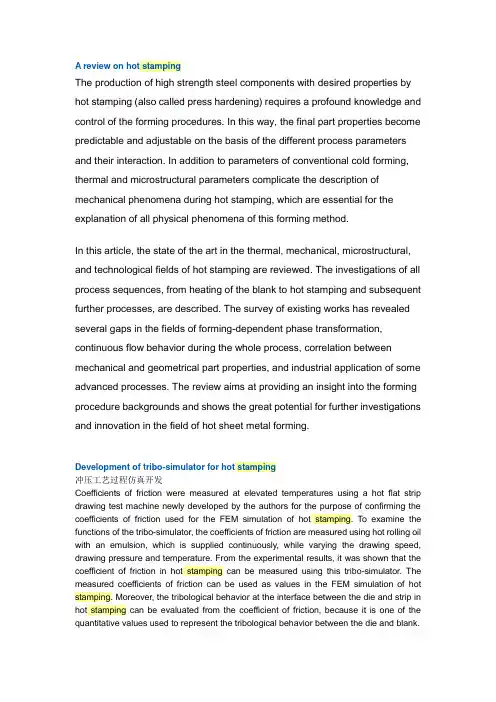
A review on hot stampingThe production of high strength steel components with desired properties by hot stamping (also called press hardening) requires a profound knowledge and control of the forming procedures. In this way, the final part properties become predictable and adjustable on the basis of the different process parameters and their interaction. In addition to parameters of conventional cold forming, thermal and microstructural parameters complicate the description of mechanical phenomena during hot stamping, which are essential for the explanation of all physical phenomena of this forming method.In this article, the state of the art in the thermal, mechanical, microstructural, and technological fields of hot stamping are reviewed. The investigations of all process sequences, from heating of the blank to hot stamping and subsequent further processes, are described. The survey of existing works has revealed several gaps in the fields of forming-dependent phase transformation, continuous flow behavior during the whole process, correlation between mechanical and geometrical part properties, and industrial application of some advanced processes. The review aims at providing an insight into the forming procedure backgrounds and shows the great potential for further investigations and innovation in the field of hot sheet metal forming.Development of tribo-simulator for hot stamping冲压工艺过程仿真开发Coefficients of friction were measured at elevated temperatures using a hot flat strip drawing test machine newly developed by the authors for the purpose of confirming the coefficients of friction used for the FEM simulation of hot stamping. To examine the functions of the tribo-simulator, the coefficients of friction are measured using hot rolling oil with an emulsion, which is supplied continuously, while varying the drawing speed, drawing pressure and temperature. From the experimental results, it was shown that the coefficient of friction in hot stamping can be measured using this tribo-simulator. The measured coefficients of friction can be used as values in the FEM simulation of hot stamping. Moreover, the tribological behavior at the interface between the die and strip in hot stamping can be evaluated from the coefficient of friction, because it is one of the quantitative values used to represent the tribological behavior between the die and blank.Die design for stamping a notebook case with magnesium alloy sheetsIn the present study, the stamping process for manufacturing a notebook top cover case with LZ91 magnesium–lithium alloy sheet at room temperature was examined using both the experimental approach and the finite element analysis. A four-operation stamping process was developed to eliminate both the fracture and wrinkle defects occurred in the stamping process of the top cover case. In order to validate the finite element analysis, an actual four-operation stamping process was conducted with the use of 0.6 mm thick LZ91 sheet as the blank. A good agreement in the thickness distribution at various locations between the experimental data and the finite element results confirmed the accuracy and efficiency of the finite element analysis. The superior formability of LZ91 sheet at room temperature was also demonstrated in the present study by successful manufacturing of the notebook top cover case. The proposed four-operation process lends itself to an efficient approach to form the hinge in the notebook with less number of operational procedures than that required in the current practice. It also confirms that the notebook cover cases can be produced with LZ91 magnesium alloy sheet by the stamping process. It provides an alternative to the electronics industry in the application of magnesium alloys.Improving the accuracy of contact-type drawbead elements in panel stamping analysis面板冲压的材料与接触类型A finite element modeling technique is proposed to improve the accuracy of contact-type drawbead elements in panel forming analyses, and a performance assessment in terms of part border and thickness predictions is presented in conjunction with panel stamping experiments of two automotive sheets. Inherent model limitations causing incorrect part geometry and thickness predictions are, firstly, evaluated considering blank deformations on a plain–strain section of a stamping die. The influence of omitted drawbead geometry and overestimated drawbead exit thickness are described analytically, and a closed form expression is obtained to correct draw-in model error. Then a sectional deformation model is used to calculate restraint force and drawbead exit thickness for a particular blank and drawbead design. The proposed technique is applied in process modeling of polygon shaped panels made of draw-quality and bake-hardenable steels. Three bead penetrations were investigated in process simulations as well as in stamping experiments. The same blankholder force was applied in all process conditions. Computed draw-in and thickness distributions were compared with on-part measurements using an experimental panel-draw die. It was determined that drawbead models based on force parameters only resulted in remarkably high thickness values at the die entry and mostly overestimated draw-in along panel border lines. An evaluation of thickness distributions computed with proposed technique showed an improved correlation with experiment results of both blank materials and confirmed the use of the drawbead exit thickness as a drawbead modeling parameter. Effects of bead penetration on panel border lines were also simulated in accord with stamping experiments.热冲压机床与设备及其冷却系统设计Design of Hot Stamping Tools with Cooling SystemHot stamping with high strength steel is becoming more popular in automotive industry. In hot stamping, blanks are hot formed and press hardened in a water-cooled tool to achieve high strength. Hence, design of the tool with necessary cooling significantly influences the final properties of the blank and the process time. In this paper a new method based on systematic optimization to design cooling ducts in tool is introduced. The optimization procedure was coupled with FE analysis and a specific evolutionary algorithm. Through this procedure each tool component was separately optimized. Subsequently, the hot stamping process was simulated both thermally and thermo-mechanically with the combination of optimized solutions.热冲压的材料机械性能Investigation of the thermo-mechanical properties of hot stamping steelsWithin the innovative hot forming process for sheet metals, called hot stamping, it is possible to combine forming and quenching in one process step. This affords the opportunity to manufacture components with complex geometric shapes, high strength and a minimum of springback which currently find applications as crash relevant components in the automotive industry. As standard material for hot stamping the quenchenable high strength steel 22MnB5 is commonly used. With regard to the numerical modeling of the process, the knowledge of thermal and thermo-mechanical properties of the material is required. To determine the thermo-mechanical material characteristics, the flow behavior of the steel 22MnB5 in the austenitic state has been investigated by conductive, hot tensile tests with a Gleeble 1500 system dependent on the time–temperature characteristic of the hot stamping process.金属钣金快速冲压先进系统Fast FE analysis system for sheet metal stamping—FASTAMPFASTAMP is a fast FE analysis system for sheet metal stamping, which is based on an improved inverse approach and dynamic explicit method. The improved algorithm successfully avoids the strain localization problem existing in plastic deformation theory to lay foundation for the inverse approach. Quadrilateral membrane elements together with DKQ bend element are used in the algorithm to considering bending effect. More accurate model is built in the system so that the process parameters, such as blank-holding force, friction and drawbead restriction, can be taken into account. Press types, eject plate and other influence factors on sheet metal forming are also considered. As a result, the system can be applied to potential defects detection, formability analysis, material selection and process verification. Product design, process planning and die design can be integrated by FASTAMP, so that product formability can be ensured, optimization of stamping process and die structure achieved.钣金冲压的电子电磁辅助自控设施Electromagnetically assisted sheet metal stampingA new approach, electromagnetically assisted sheet metal stamping, has been developed to alter strain distribution and improve formability in sheet metal stamping. In this study,this new approach was applied to form a non-symmetric panel from Al 6111-T4. The results show that this new approach greatly increased the draw depth of the formed panel, compared with conventional stamping. A detailed analysis of strain distribution, stretching and draw-in shows that both a more homogeneous strain distribution and enhanced draw-in contribute to producing deeper pans in a single press operation. This work demonstrates the feasibility of electromagnetically assisted sheet metal stamping, which offers a much improved ability to make complex components in a single press stroke as compared to conventional stamping.多步钣金冲压中的材料厚度变化率保证使用的优化软件Minimization of the thickness variation in multi-step sheet metal stampingThis paper presents an efficient method to optimize the intermedial tool surfaces in the multi-step sheet metal stamping process to obtain improved quality of a product at the end of forming. The proposed method is based on a combination of finite element modeling (FEM) and the response surface method (RSM). The objective of the optimization is to minimize the thickness variation of the part at the final stage. The constraint function of local fracture is introduced by the use of the forming limit curve (FLC). With acceptable accuracy and high efficiency, the multi-step inverse method is used together with RSM to check various intermediate surfaces to search for the optimal shape parameters. After the convergence of the optimization, the result is validated using commercial software DYNAFORM®.Application of a feasible formability diagram for the effective design in stamping processes of automotive panels图表化冲压过程柔性化设计方法的应用自动面板控制The objective of this study is to propose a method of process design that uses a feasible formability diagram, which denotes the safe region without fracture and wrinkle, for the effective and rapid design of stamping processes. To determine the feasible formability diagram, FE-analyses have been performed for combinations of process variables that correspond to the orthogonal array of design of experiments. Subsequently, thecharacteristic values for fracture and wrinkle have been estimated from the results of FE-analyses on the basis of the forming limit diagram. The characteristic values for all combinations within a whole range of process variables have been predicted through the training of an artificial neural network. The feasible formability diagram has been finally determined for all combinations of process variables. The stamping processes of automotive panels to support suspension module, such as the turret suspension and the wheel house, have been taken as examples to verify the effectiveness of process design through feasible formability diagram. A comparison of the FE-simulation results with the experimental results reveals that the design of stamping processes through feasible formability diagram is efficient and suitable for actual processes.Development of nano-columnar carbon coating for dry micro-stampingTwo-stage cold stamping of magnesium alloy cups having small corner radius杯型零件的两步化冲压方法A two-stage cold stamping process for forming magnesium alloy cups having a small corner radius from commercial magnesium alloy sheets was developed. In the 1st stage, a cup having large corner radius was formed by deep drawing using a punch having large corner radius, and the corner radius of the cup was decreased by compressing the side wall in the 2nd stage. In the deep drawing of the 1st stage, fracture was prevented by decreasing the concentration of deformation with the punch having large corner radius. The magnesium alloy sheets were annealed at 500 °C to increase the cold formability. Circular and square cups having small corner radii were formed by the two-stage cold stamping. For the circular cup, the height of the cup was increased by ironing the side wall in the 1st stage. The radii of the bottom and side corners of the square cup were reduced by a rubber punch for applying pressure at these corners in the 2nd stage. It was found that comparatively shallow magnesium alloy square cups used as cases of laptop computers and mobile phones can be satisfactorily formed at room temperature without heating by the two-stage stamping.Numerical simulation of hot stamping of quenchable boron steelQuenchable boron steel is a new type of ultra-high-strength steel used for automotive parts to reduce the weight of automobiles and maintain the safety requirements. On the basis of experimental data of mechanics and thermal physical properties, a material model under hot stamping condition of quenchable steel was set up, and the numerical simulation to the whole hot stamping process of hot forming, quenching and spring-back of bending parts was made with ABAQUS software. The results show that the springback of hot stamping parts increases when the blank-holder force (BHF) decreases; and it increases when the clearance between punch and dies increases and when the die radius increases. The simulation results are basically in agreement with experimental results.热冲压工艺过程的数字化仿真A numerical investigation to the strategies of the localised heating for micro-part stampingLocal heating renders attractive characteristics for achieving high efficiency of metal forming. With reference to micro-part stamping, two localised-heating methods, electrical heating and laser-heating, are investigated with FE simulation. Results show that electrical heating would result in an advantageous distribution of the temperature in a steel work-material. A desired temperature distribution may also be achievable for a copper work-material, if a high-powered laser beam is used. Both electrical heating and laser-heating enable reduction of the stamping force and increase of the aspect ratio that is achievable by stamping. The simulation also demonstrates that both electrical heating and laser-heating are able to result in the desired temperature-distributions at sufficiently high heating-rates and that the methods are easy to be implemented. The comparison further shows that electrical heating is more favourable for engineering applications.微小零件的冲压过程策略与方式仿真Prevention of oxidation in hot stamping of quenchable steel sheet by oxidation preventive oilOxidation in hot stamping of quenchable steel sheets heated in an electrical furnace was prevented by coating the sheets with oxidation preventive oil. A solid film is generated on the surface of the sheet by drying the coated sheet, and the film changes i nto a liquefied film having an oxidation barrier at elevated temperatures. Hot hat-shaped bending of the coated sheet was performed to examine the properties of the products. For the bent products, the oxidation preventive oil was effective, the shape accuracy was very high and the hardness increased to a level of 1.5 GPa in tensile strength.热冲压用油防止氧化。
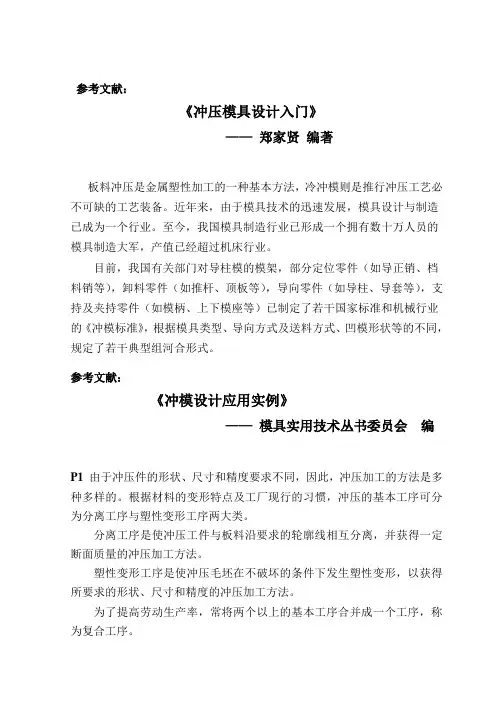
参考文献:《冲压模具设计入门》——郑家贤编著板料冲压是金属塑性加工的一种基本方法,冷冲模则是推行冲压工艺必不可缺的工艺装备。
近年来,由于模具技术的迅速发展,模具设计与制造已成为一个行业。
至今,我国模具制造行业已形成一个拥有数十万人员的模具制造大军,产值已经超过机床行业。
目前,我国有关部门对导柱模的模架,部分定位零件(如导正销、档料销等),卸料零件(如推杆、顶板等),导向零件(如导柱、导套等),支持及夹持零件(如模柄、上下模座等)已制定了若干国家标准和机械行业的《冲模标准》,根据模具类型、导向方式及送料方式、凹模形状等的不同,规定了若干典型组河合形式。
参考文献:《冲模设计应用实例》——模具实用技术丛书委员会编P1 由于冲压件的形状、尺寸和精度要求不同,因此,冲压加工的方法是多种多样的。
根据材料的变形特点及工厂现行的习惯,冲压的基本工序可分为分离工序与塑性变形工序两大类。
分离工序是使冲压工件与板料沿要求的轮廓线相互分离,并获得一定断面质量的冲压加工方法。
塑性变形工序是使冲压毛坯在不破坏的条件下发生塑性变形,以获得所要求的形状、尺寸和精度的冲压加工方法。
为了提高劳动生产率,常将两个以上的基本工序合并成一个工序,称为复合工序。
P8 构成冲模的零、部件可分为工艺构件和辅助构件两部分。
定位零件模具上定位零件的作用是使毛坯在模具上能够正确定位。
毛坯在模具中的定位有两个内容:一是在送料方向上的定位,用来控制送料的进距,通常称为挡料;二是在与送料方向垂直方向上的定位,通常称为送进导向。
常用零件有定位板和定位销、档料销、导正销、导尺和侧刃等。
P12 常用卸料、出件及压料零、部件卸料板一般为刚性卸料板和弹性卸料板两种形式。
刚性卸料板用螺钉与销钉固定在下模上,能承受的卸料力较大,常用于厚板冲压件的卸料。
其卸料可靠、安全;但操作不便,生产效率不高。
刚性卸料板和凸模的单边间隙一般取0.1~0.5mm。
刚性卸料板的厚度与卸料力大小及尺寸有关,一般取5~10m。
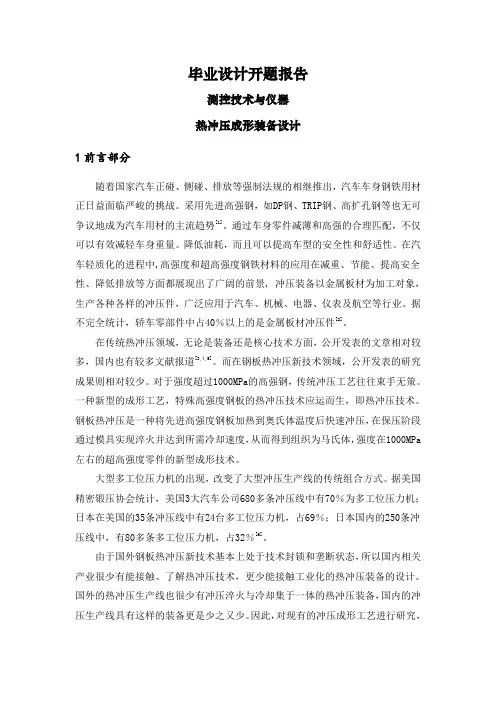
毕业设计开题报告测控技术与仪器热冲压成形装备设计1前言部分随着国家汽车正碰、侧碰、排放等强制法规的相继推出,汽车车身钢铁用材正日益面临严峻的挑战。
采用先进高强钢,如DP钢、TRIP钢、高扩孔钢等也无可争议地成为汽车用材的主流趋势[1]。
通过车身零件减薄和高强的合理匹配,不仅可以有效减轻车身重量。
降低油耗,而且可以提高车型的安全性和舒适性。
在汽车轻质化的进程中,高强度和超高强度钢铁材料的应用在减重、节能、提高安全性、降低排放等方面都展现出了广阔的前景, 冲压装备以金属板材为加工对象,生产各种各样的冲压件,广泛应用于汽车、机械、电器、仪表及航空等行业。
据不完全统计,轿车零部件中占40%以上的是金属板材冲压件[2]。
在传统热冲压领域,无论是装备还是核心技术方面,公开发表的文章相对较多,国内也有较多文献报道[3,4,5]。
而在钢板热冲压新技术领域,公开发表的研究成果则相对较少。
对于强度超过1000MPa的高强钢,传统冲压工艺往往束手无策。
一种新型的成形工艺,特殊高强度钢板的热冲压技术应运而生,即热冲压技术。
钢板热冲压是一种将先进高强度钢板加热到奥氏体温度后快速冲压,在保压阶段通过模具实现淬火并达到所需冷却速度,从而得到组织为马氏体,强度在1000MPa 左右的超高强度零件的新型成形技术。
大型多工位压力机的出现,改变了大型冲压生产线的传统组合方式。
据美国精密锻压协会统计,美国3大汽车公司680多条冲压线中有70%为多工位压力机;日本在美国的35条冲压线中有24台多工位压力机,占69%;日本国内的250条冲压线中,有80多条多工位压力机,占32%[6]。
由于国外钢板热冲压新技术基本上处于技术封锁和垄断状态,所以国内相关产业很少有能接触、了解热冲压技术,更少能接触工业化的热冲压装备的设计。
国外的热冲压生产线也很少有冲压淬火与冷却集于一体的热冲压装备,国内的冲压生产线具有这样的装备更是少之又少。
因此,对现有的冲压成形工艺进行研究,并针对高强度钢的热成形装置进行设计,进而从机电一体化和机械机构设计出发,从根本上解决高强度钢热冲压淬火与冷却生产工艺的改善,是一项不但有学术价值,而且将会产生巨大经济效益和提高汽车安全性能。
冲压工艺文献综述范文英文回答:Stamping process is a widely used manufacturing technique in various industries, including automotive, aerospace, and electronics. It involves the use of a press machine to shape and form metal sheets into desired shapes and sizes. In this process, a die and a punch are used to apply force on the metal sheet, causing it to deform and take the shape of the die.One of the advantages of stamping process is its high production efficiency. With the use of automated press machines, large quantities of parts can be produced in a short period of time. This is particularly beneficial for industries that require high volume production, such as automotive industry. Additionally, stamping process allows for high precision and accuracy in forming complex shapes. The use of dies and punches with specific designs and dimensions ensures consistent and repeatable results.Another advantage of stamping process is its versatility. It can be used to form a wide range of materials, including steel, aluminum, and copper. Furthermore, different types of stamping processes can be employed to achieve different results. For example, deep drawing is a type of stamping process used to create cylindrical or box-shaped parts, while progressive stamping is used to produce complex parts with multiple operations.Despite its advantages, stamping process also has some limitations. One of the challenges in stamping is the occurrence of defects, such as wrinkles, cracks, and springback. These defects can affect the quality and functionality of the stamped parts. To overcome these challenges, various techniques and strategies, such as adjusting the process parameters and using lubricants, can be employed.In conclusion, stamping process is a widely used manufacturing technique that offers high production efficiency, precision, and versatility. It is an essentialprocess in the production of various metal parts. However,it also presents challenges that need to be addressed to ensure the quality of the stamped parts.中文回答:冲压工艺是一种广泛应用于各个行业的制造技术,包括汽车、航空航天和电子等。
汽车冲压生产论文总结第1篇时光如水,日月如梭,转眼间我来到车间工作已经有十个多月的的时光,这十个多月的时光,承蒙车间领导和各位同事的帮忙指导,再通过自己的努力,在思想上、业务工作水平上都有了很大的提高,基本上完成了自己的本职工作,并取得了一些较好的成绩。
现将一年来工作总结如下:一、努力学习、勤奋工作日常工作中,我用心向其他人员学习。
我觉得,每位同事都是我的老师,他们中有业务高手,有技术尖兵。
正是不断地虚心向他们求教,使我在调入车间后,在最短的时光内熟悉了工作环境,懂得了各种材料的使用、一般问题出现的原因、维修的方法也都基本掌握。
在业务上,将以前的维修工作经验和车间的实际状况结合起来,使自身的素质和工作潜力得以不断提高。
二、班组管理在六月份,我被任命为维修主任,我深感自己肩上任务的重大。
为了不辜负领导的期望,我在严格要求自己的同时,还加强了班组管理:1、按照班前、后会议程序要求,开好会议,并做好记录。
将矿部、车间的各种文件和要求快速的传达给班组员工,使自己上承下达、承上启下的作用得以充分发挥。
使班组工人尽量了解好、了解透彻上级的`精神。
2、加强班组管理。
我制定了较为详细的班组规章制度和考核标准,性格强调从根本的管理入手。
三、进行设备规划,缩短维修周期我和车间领导一起,对设备进行了规划、从维修组织(设计、测量)到维修控制(工时、材料、库存量、费用),都做到有据可查。
我认为,做好设备的保养工作,将设备的备品备件预备的充足,是减少在故障发生后缩短维修时光的必要前提。
维修的方式有两种,一是事后维修,二是定期维修。
我们不能单纯的做到损坏了再维修,只要设备能用就尽量用,坏了再修。
而是就应在设备损坏前将故障排除,降低设备的故障率。
四、努力做好节资降耗和维修工作本人任维修主任以来,十分重视节资降耗和维修工作。
主要如下:(1)修旧利废16吨;(2)在对绿皮吉普车的修理过程中,维修班利用旧件,组装了后传动轴、后桥差速器、刹车总泵、后弹簧钢板;(3)对28#铲斗进行翻新;(4)下放并安装3立方内燃铲运机、立方电动铲运机、铲运机各2台;(5)下放复新凿岩台车一台;(6)架设风水管路1000多米;(7)安装钢溜井30多节;(8)新架设格筛、护栏10多个;(9)对各种安全防护设施及设备出现的临时性突发故障,做到及时抢修;(10)大修内燃机2次。
毕业设计开题报告机械设计制造及自动化V型件热冲压成形工艺及其模具设计1前言部分近年来世界汽车产销量与日俱增,正以越来越大的影响力改变着人们的工作与生活,但随之而来的能源短缺、环境污染等一系列问题也日益突出。
随着国际原油和国内成品油价格的上涨,轻型、节能、环保、安全舒适、低成本成为各汽车制造厂家追求的目标,节能减排已成为世界汽车工业界亟待解决的问题。
中国汽车工业起步虽然较晚,但近十年来,汽车工业处于快速发展的阶段,汽车的产量和保有量大幅攀升。
根据国家统计中心提供数据,2007年中国汽车全年产量达到892万辆,实现长达连续9年的两位数增长;受全球金融危机影响,2008年中国汽车产量为934.5万辆,同比增长5.2%;今年1~11月,汽车累计产销已突破1220万辆,预计全年产销量将突破1300万辆,产销量增长400多万辆,将超越美国成为全球的第一大汽车消费国。
预测显示2030年中国汽车保有量将达到3.15亿辆,其中家用汽车的比例将从2003年的19%上升到2030年的78%。
汽车工业的迅猛发展,一方面促进了经济的发展,带动了石油化工、钢铁冶金、有色金属材料、橡胶工业、电子工业、纺织工业、机器制造等产业的发展;另一方面加剧了中国社会的能源危机与环境危机。
所以汽车的轻量化显得越来越重要。
实现汽车轻量化主要有3种途径。
一是改进汽车结构,使部件薄壁化、中空化、小型化及复合化,在结构设计上采用前轮驱动,将前置发动机后轮驱动结构改为前轮驱动结构,减轻传动系统质量,目前欧洲汽车已有约60%改为前轮驱动。
二是开发应用新型轻质材料,如使用铝、镁合金等有色金属、塑料及非金属复合材料等密度小、强度高的轻质材料,或者截面厚度较薄的高强度钢。
三是采用先进的制造工艺,将两个或多个零件集成为一个零件;研发各种先进的成形技术,如激光拼焊、液压成形等。
由此,钢板占据了汽车的材料的75%,而车身质量约占整车质量的30%左右,所以,高强度钢板具有使汽车轻量化、节约能源、降低成本、低碳环保等多种天然优势。
冲压工艺文献综述范文一、冲压工艺的发展历程最早的冲压工艺可以追溯到古希腊时期。
古希腊人利用木制模具,通过手工操作对金属材料进行冲压加工。
随着工业革命的到来,冲压工艺得到了快速发展。
19世纪末,出现了机械化冲压设备,如手动冲床和液压冲床。
20世纪初,随着电气化技术的引入,出现了电动冲床和自动化冲床。
20世纪50年代,出现了数控冲床,标志着冲压工艺步入了数字化时代。
二、冲压工艺的基本原理冲压工艺通过在模具之间施加力使金属材料发生塑性变形,从而得到所需的形状和尺寸。
冲压工艺包括以下几个步骤:设计模具、选材、热处理、摸具、焊接、安装、试制、调整和使用,其中设计模具是冲压工艺中至关重要的一环。
三、冲压工艺的材料选择在冲压工艺中,金属材料选择直接影响到产品质量和生产成本。
常见的冲压材料有冷轧板、热轧板、镀锌板、不锈钢、铝合金等。
不同材料有不同的力学性能和加工性能,需要根据产品的要求和批量选择合适的材料。
四、冲压工艺的模具设计模具在冲压工艺中起着至关重要的作用,直接关系到产品的成型质量和生产效率。
模具设计需要考虑以下几个要素:产品几何形状、材料特性、加工工艺、成本等。
合理的模具设计可以减少废品率、提高生产效率,降低生产成本。
五、冲压工艺的优势与发展趋势冲压工艺具有高效、精密、经济、节能等优点,是现代工业生产中不可或缺的一种重要工艺。
未来,随着新材料、新工艺的不断涌现,冲压工艺将进一步发展和完善,为工业制造带来更多的机遇和挑战。
六、结语冲压工艺作为一种重要的金属加工工艺,在现代工业生产中发挥着不可替代的作用。
通过对冲压工艺的综述,我们可以看到其发展历程、基本原理、材料选择、模具设计、优势与发展趋势等方面的内容,对于深入了解和应用冲压工艺具有一定的参考价值。
希望本文能对读者有所启发,促进冲压工艺在工业领域的广泛应用与发展。
文献综述2011年5月7日一、模具是工业生产中的重要工艺装备,是国民经济各部门发展的重要基础,是衡量一个国家的生产力水平的重要标志之一,模具已成为当代工业生产的重要手段和工艺发展方向,也是机械制造业中技术先进、影响深远的重要工艺装备,具有生产效率高、材料利用率高、制件质量优良、工艺适应性好等特点,随着改革开放和国民经济的高速发展,推动了模具技术和工业的心发展势头,在仪器仪表、家用电器、交通、通讯等各行业中,被广泛应用于汽车、机械、航天、航空、轻工、电子等行业。
模具设计的水平高低、模具的制造能力强弱以及模具的质量的优劣,将直接影响各种产品的质量、经济效率的增长及整体工业水平的提高,现代工艺的发展和生产效益的提升,绝大程度上是取决于模具的发展和技术经济水平,模具工艺成为高新技术产业的重要组成部分,现代模具是高技术背景下的工艺密集型工业,其水平的高低,在很大程度上决定产品的质量、效益和产品的开发与制造能力。
二、我国在模具制造和工艺方面,无论是技术还是发展水平都已得到比较大的发展和提高,但由于各种原因,未能与国民经济的高速发展的需要同步,无法达到各项指标的饱和,迫于需要只能花费大量资金向国外进口模具来满足国内的需求,产生诸类原因在于:(1)专业和标准化程度低。
(2)模具制造精度低、周期长。
(3)模具品种少,效率低,经济效率也差。
(4)制造周期长,模具精度不高,制造技术相对落后。
(5)模具使用寿命短,新材料使用量都达不到11%,资源没达到高效利用。
(6)管理不科学,导致落后,力量不集中,导致顶尖力量无法发挥或流失。
(7)未系统化和专业化培养专业人才,导致没有创新元素滋生的主要原因。
根据我国的模具技术的发展现状及存在的问题,我认为应往一下几方面发展:(1)开发、发展精密、复杂、大型、长寿命模具,以满足国内市场的需求。
(2)加速模具标准化和商业化,以提高模具质量,缩短模具制造周期。
(3)大力开发和推广应用模具CAD/CAM技术,提高模具制造过程和自动化程度。
文献综述摘要:在科技技术日益发展的今天,冲压工艺得到不断的发展,在工业生产中的作用越来越重要。
冲压技术在新技术、新工艺、新设备、新材料的涌现下,不断革新和发展。
关键词:冲压工艺、复合模、工艺设计Abstract:In the increasing development of science and technol ogy today,the stamping process to get continuous dev elopment and playsmore and more important role in the industrial produ ction.Stamping technology in the new technology, new technology, new equipment, the emergence of new mat erials, continuous innovation and development.Keywords: stamping process, compound die, process design一.冲压的概念及其优点1.1冲压的概念冲压是利用安装在冲压设备(主要是压力机)上的模具对材料施加压力,使其产生分离或塑性变形,从而获得所需零件(俗称冲压或冲压件)的一种压力加工方法。
冲压通常是在常温下对材料进行冷变形加工,且主要采用板料来加工成所需零件,所以也叫冷冲压或板料冲压。
冲压是材料压力加工或塑性加工的主要方法之一,隶属于材料成型工程术。
冲压所使用的模具称为冲压模具,简称冲模。
冲模是将材料(金属或非金属)批量加工成所需冲件的专用工具。
冲模在冲压中至关重要,没有符合要求的冲模,批量冲压生产就难以进行;没有先进的冲模,先进的冲压工艺就无法实现。
冲压工艺与模具、冲压设备和冲压材料构成冲压加工的三要素,只有它们相互结合才能得出冲压件。
1.2冲压的优点冷冲压和线切割相比较,具有生产效率高、加工成本低、材料利用率高、产品尺寸精度稳定、操作简单容易实现机械化和自动化等一系列有点,特别适合于大批量生产。
冲压模具成形作为现代工业中一种十分重要的加工方法,用以生产各种板料零件,具有很多独特的优势,其成形件具有自重轻、刚度大、强度高、互换性好、成本低、生产过程便于实现机械自动化及生产效率高等优点,是一种其它加工方法所不能相比和不可替代的先进制造技术,在制造业中具有很强的竞争力,被广泛应用于汽车、能源、机械、信息、航空航天、国防工业和日常生活的生产之中。
在吸收了力学、数学、金属材料学、机械科学以及控制、计算机技术等方面的知识后,已经形成了冲压学科的成形基本理论。
以冲压产品为龙头,以模具为中心,结合现代先进技术的应用,在产品的巨大市场需求刺激和推动下,冲压成形技术在国民经济发展、实现现代化和提高人民生活水平方面发挥着越来越重要的作用。
现代冲压模具生产是一种大规模继续作业的制造方式,由于高新技术的参与和介入,冲压生产方式由初期的手工操作逐步进化为集成制造。
生产过程逐步实现机械化、自动化、并且正在向智能化、集成化的方向发展。
实现自动化冲压作业,体现安全、高效、节材等优点,已经是冲压模具生产的发展方向。
日常生活中人们使用的很多用具是用冲压方法制造的,例如不锈钢饭缸,它就是用一块圆形金属板料在压床上利用模具对圆形板料加压而冲出来的。
可以看出,冷冲压是一种在常温(冷态)下利用冲模在压床上对各种金属(或非金属)板料施加压力使其分离或者变形而得到一定形状零件的金属压力加工方法。
近几十年来,冲压技术有了飞速的发展,它不仅表现在许多新工艺与新技术在生产的广泛应用上,如:旋压成形、软模具成形、高能率成形等,更重要的是人们对冲压技术的认识与掌握的程度有了质的飞跃。
1.3复合模具的优点符合模具以为不受送料误差的影响所以有很多优点:(1)内外形相对位置及零件尺寸的一致性非常好,生产零件表面平整,并且精度高(2)模具结构紧凑,对压力机的平台要求不高(3)可以充分利用短料和余料(4)适合冲裁簿料和脆性或软性材料二.国内外研究现状模具生产技术水平的高低,已成为衡量一个国家产品制造水平高低的重要标志。
因为模具在很大程度上决定着产品的质量、效益和新产品的开发能力。
我国的模具工业的发展,也日益受到人们的关注和重视。
近几年,我国模具工业一直以每年15%左右的增长速度发展。
2.1模具CAD/CAM技术状况我国模具CAD/CAM技术的发展已有20多年历史。
由原华中工学院和武汉733厂于1984年共同完成的精冲模CAD/CAM系统是我国第一个自行开发的模具CAD/CAM系统21世纪开始CAD/CAM技术逐渐普及,现在具有一定生产能力的冲压模具企业基本都有了CAD/CAM技术。
其中部分骨干重点企业还具备各CAE能力。
模具CAD/CAM技术能显著缩短模具设计与制造周期,降低生产成本,提高产品质量,已成为人们的共识。
在“八五”、“九五”期间,已有一大批模具企业推广普及了计算机绘图技术,数控加工的使用率也越来越高,并陆续引进了相当数量的CAD/CAM系统。
2.2.模具设计与制造能力状况在国家产业政策的正确引导下,经过几十年努力,现在我国冲压模具的设计与制造能力已达到较高水平,包括信息工程和虚拟技术等许多现代设计制造技术已在很多模具企业得到应用。
虽然如此,我国的冲压模具设计制造能力与市场需要和国际先进水平相比仍有较大差距。
这些主要表现在高档轿车和大中型汽车覆盖件模具及高精度冲模方面,无论在设计还是加工工艺和能力方面,都有较大差距。
轿车覆盖件模具,具有设计和制造难度大,质量和精度要求高的特点,可代表覆盖件模具的水平。
虽然在设计制造方法和手段方面已基本达到了国际水平,模具结构功能方面也接近国际水平,在轿车模具国产化进程中前进了一大步,但在制造质量、精度、制造周期等方面,与国外相比还存在一定的差距。
标志冲模技术先进水平的多工位级进模和多功能模具,是我国重点发展的精密模具品种。
有代表性的是集机电一体化的铁芯精密自动阀片多功能模具,已基本达到国际水平。
但总体上和国外多工位级进模相比,在制造精度、使用寿命、模具结构和功能上,仍存在一定差距。
2.3.专业化程度及分布状况我国模具行业专业化程度还比较低,模具自产自配比例过高。
国外模具自产自配比例一般为30%,我国冲压模具自产自配比例为60%。
这就对专业化产生了很多不利影响。
现在,技术要求高、投入大的模具,其专业化程度较高,例如覆盖件模具、多工位级进模和精冲模等。
而一般冲模专业化程度就较低。
由于自配比例高,所以冲压模具生产能力的分布基本上跟随冲压件生产能力的分布。
但是专业化程度较高的汽车覆盖件模具和多工位、多功能精密冲模的专业生产企业的分布有不少并不跟随冲压件能力分布而分布,而往往取决于主要投资者的决策。
3. 冲压的基本工序及模具冲压加工的零件种类繁多,各类零件的形状、尺寸和精度要求又各不相同,因而生产中采用的冲压工艺方法也是多种多样的。
概括起来,可分为分离工序和成形工序两大类;分离工序是指使坯料沿一定的轮廓线分离而获得一定形状、尺寸和断面质量的冲压(俗称冲裁件)的工序;成形工序是指使坯料在不破裂的条件下产生塑性变形而获得一定形状和尺寸的冲压件的工序。
上述两类工序,按基本变形方式不同又可分为冲裁、弯曲、拉深和成形四种基本工序,每种基本工序还包含有多种单一工序。
在实际生产中,当冲压件的生产批量较大、尺寸较少而公差要求较小时,若用分散的单一工序来冲压是不经济甚至难于达到要求。
这时在工艺上多采用集中的方案,即把两种或两种以上的单一工序集中在一副模具内完成,称为组合的方法不同,又可将其分为复合-级进和复合-级进三种组合方式。
复合冲压——在压力机的一次工作行程中,在模具的同一工位上同时完成两种或两种以上不同单一工序的一种组合方法式。
级进冲压——在压力机上的一次工作行程中,按照一定的顺序在同一模具的不同工位上完面两种或两种以上不同单一工序的一种组合方式。
复合-级进——在一副冲模上包含复合和级进两种方式的组合工序。
冲模的结构类型也很多。
通常按工序性质可分为冲裁模、弯曲模、拉深模和成形模等;按工序的组合方式可分为单工序模、复合模和级进模等。
但不论何种类型的冲模,都可看成是由上模和下模两部分组成,上模被固定在压力机工作台或垫板上,是冲模的固定部分。
工作时,坯料在下模面上通过定位零件定位,压力机滑块带动上模下压,在模具工作零件(即凸模、凹模)的作用下坯料便产生分离或塑性变形,从而获得所需形状与尺寸的冲件。
上模回升时,模具的卸料与出件装置将冲件或废料从凸、凹模上卸下或推、顶出来,以便进行下一次冲压循环。
三.发展趋势据相关专业人士分析,未来十年,中国模具工业和技术的主要发展方向将主要集中在以下十个方面。
(1)模具结构日趋大型、精密、复杂及寿命日益提高随着零件微型化和模具结构发展的要求(如多工位级进模工位数的增加,其步距精度的提高),模具精度已由原来的5μm 提高到2~3μm,今后有些模具加工精度公差更是要求在1μm 以下,这必将促进超精密加工的发展。
(2)CAD/CAE/CAM 技术在模具设计制造中的广泛应用模具制造是设计的延续,推行模具设计与制造一体化可达到优化设计的要求。
实践证明,模具CAD/CAM/CAE 技术是当代最合理的模具生产方式,既可用于建模、为数控加工提供NC 程序,也可针对不同的模具类型,以相应的基础理论,通过数值模拟方法达到预测产品成型(形)过程的目的,改善模具结构。
从CAD/CAE/CAM 一体化的角度分析,其发展趋势是集成化、三维化、智能化和网络化,其中心思想是让用户在统一的环境中实现CAD/CAE/CAM 协同作业,以便充分发挥各单元的优势和功效。
因此,应大力进行ANSYS、MSC、Moldflow、Dynaform 等高端辅助设计制造软件的培训、推广和应用。
(3)快速经济制模技术的推广应用快速模具制造及快速成型技术(RP)是在近两年内迅速发展起来的,并正向着高精度、更快捷的方向发展。
与传统的模具技术相比,该技术具有制模周期短、成本低的特点,是综合经济效益较显著的模具制造技术。
具体新技术包括:快速原型制造技术(RPM)、表面现象成形技术、浇铸成形制模技术、冷挤压及超塑成形制模技术、无模多点成形技术、KEVRON 钢带冲裁落料制模技术以及模具毛坯快速制造技术。
此外,氮气弹簧压边与卸料、快速换模、冲压单元组合、刃口堆焊以及实型铸造冲模刃口镶块等辅助技术也有极大提高了快速经济制模的综合技术水平。
(4)新型技术在塑料模具中的推广应用采用新型热流道技术是塑料模设计制造中的一大变革,可显著提高模具制造的生产效率和质量,并能大幅度节省制作的原材料和节约能源,国外模具企业已有一半用上了该项技术,甚至已达80%以上;气体辅助注射成型也是塑料成型的一种新工艺,它具有注射压力低、制品翘曲变形少、表面好、易于成型、壁厚差异较大等优点,可在保证产品质量的前提下,大幅度降低成本。